CHCDIS005 Assessment 1: Written Questions on Disability Services
VerifiedAdded on 2022/12/23
|27
|8142
|1
Homework Assignment
AI Summary
This document presents the completed Assessment Task 1: Written Questions for the CHCDIS005 unit, focusing on developing and providing person-centred service responses. The assessment covers a range of topics related to disability services, including models of service delivery such as the Least Restrictive Principle and Person-Centred Planning, and the impact of the UNCRPD. The answers address key areas of the Disability Discrimination Act 1992, the National Standards for Disability Services, examples of workplace discrimination, the importance of 'dignity of risk,' and the 'duty of care' for disability support workers. The document provides detailed responses to each of the 17 questions, demonstrating a comprehensive understanding of the unit's learning objectives. The student has used external sources and provided references where needed to support their answers. The assessment is designed to evaluate the student's knowledge of person-centred approaches and legal and ethical considerations in the disability sector.
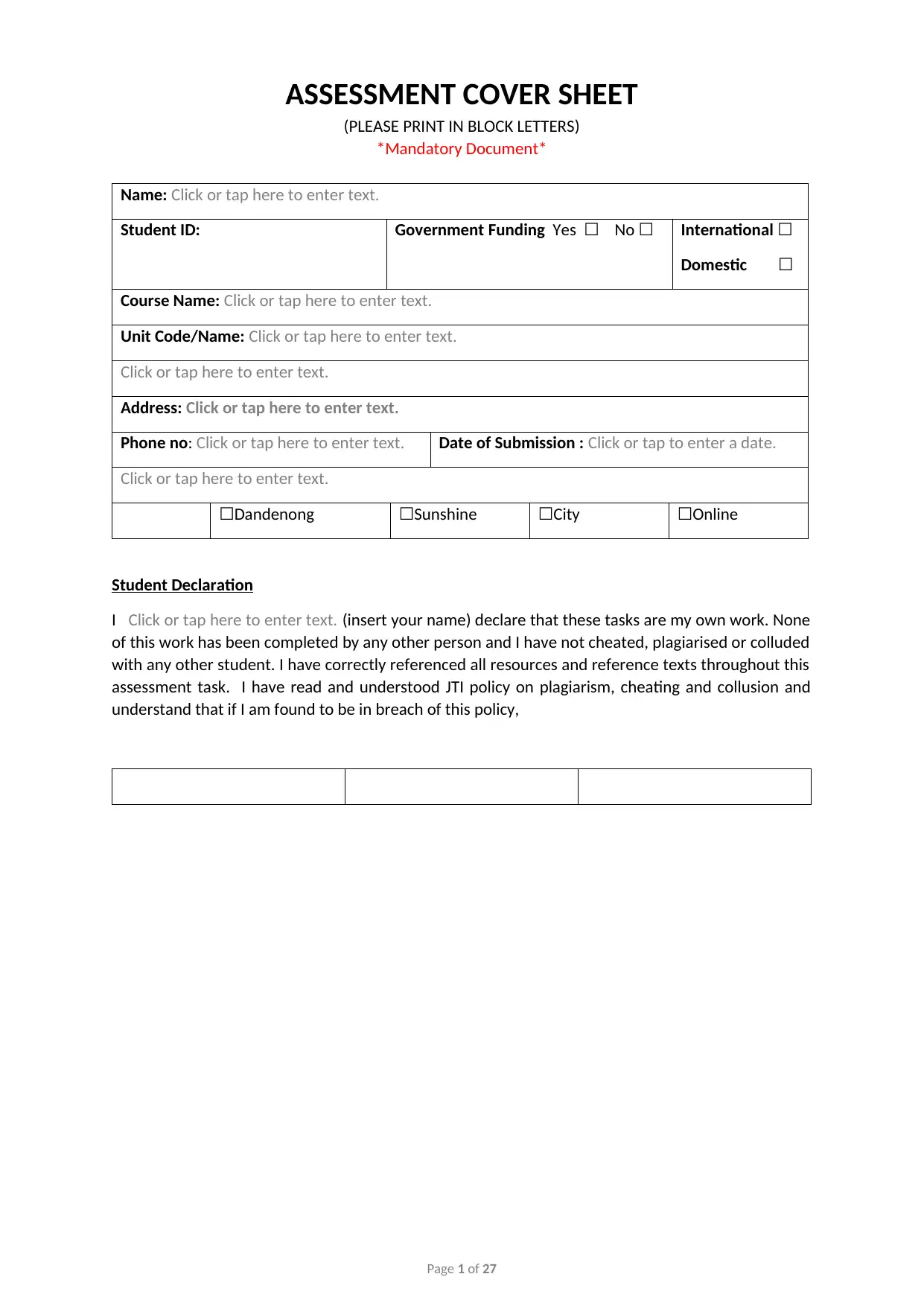
ASSESSMENT COVER SHEET
(PLEASE PRINT IN BLOCK LETTERS)
*Mandatory Document*
Name: Click or tap here to enter text.
Student ID: Government Funding Yes ☐ No ☐ International ☐
Domestic ☐
Course Name: Click or tap here to enter text.
Unit Code/Name: Click or tap here to enter text.
Click or tap here to enter text.
Address: Click or tap here to enter text.
Phone no: Click or tap here to enter text. Date of Submission : Click or tap to enter a date.
Click or tap here to enter text.
☐Dandenong ☐Sunshine ☐City ☐Online
Student Declaration
I Click or tap here to enter text. (insert your name) declare that these tasks are my own work. None
of this work has been completed by any other person and I have not cheated, plagiarised or colluded
with any other student. I have correctly referenced all resources and reference texts throughout this
assessment task. I have read and understood JTI policy on plagiarism, cheating and collusion and
understand that if I am found to be in breach of this policy,
Page 1 of 27
(PLEASE PRINT IN BLOCK LETTERS)
*Mandatory Document*
Name: Click or tap here to enter text.
Student ID: Government Funding Yes ☐ No ☐ International ☐
Domestic ☐
Course Name: Click or tap here to enter text.
Unit Code/Name: Click or tap here to enter text.
Click or tap here to enter text.
Address: Click or tap here to enter text.
Phone no: Click or tap here to enter text. Date of Submission : Click or tap to enter a date.
Click or tap here to enter text.
☐Dandenong ☐Sunshine ☐City ☐Online
Student Declaration
I Click or tap here to enter text. (insert your name) declare that these tasks are my own work. None
of this work has been completed by any other person and I have not cheated, plagiarised or colluded
with any other student. I have correctly referenced all resources and reference texts throughout this
assessment task. I have read and understood JTI policy on plagiarism, cheating and collusion and
understand that if I am found to be in breach of this policy,
Page 1 of 27
Paraphrase This Document
Need a fresh take? Get an instant paraphrase of this document with our AI Paraphraser

Page left intentionally blank
Page 2 of 27
Page 2 of 27
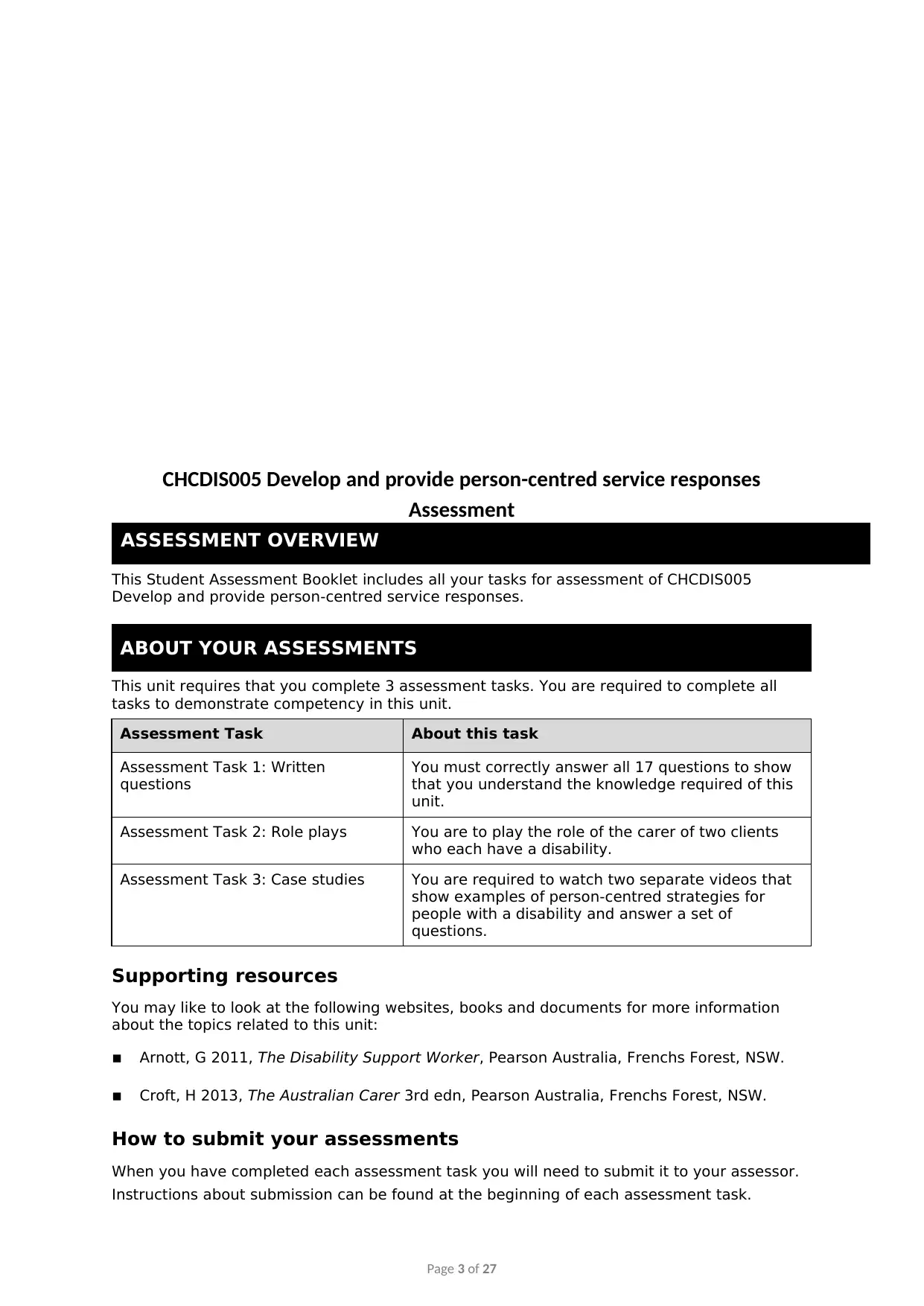
CHCDIS005 Develop and provide person-centred service responses
Assessment
ASSESSMENT OVERVIEW
This Student Assessment Booklet includes all your tasks for assessment of CHCDIS005
Develop and provide person-centred service responses.
ABOUT YOUR ASSESSMENTS
This unit requires that you complete 3 assessment tasks. You are required to complete all
tasks to demonstrate competency in this unit.
Assessment Task About this task
Assessment Task 1: Written
questions
You must correctly answer all 17 questions to show
that you understand the knowledge required of this
unit.
Assessment Task 2: Role plays You are to play the role of the carer of two clients
who each have a disability.
Assessment Task 3: Case studies You are required to watch two separate videos that
show examples of person-centred strategies for
people with a disability and answer a set of
questions.
Supporting resources
You may like to look at the following websites, books and documents for more information
about the topics related to this unit:
▪ Arnott, G 2011, The Disability Support Worker, Pearson Australia, Frenchs Forest, NSW.
▪ Croft, H 2013, The Australian Carer 3rd edn, Pearson Australia, Frenchs Forest, NSW.
How to submit your assessments
When you have completed each assessment task you will need to submit it to your assessor.
Instructions about submission can be found at the beginning of each assessment task.
Page 3 of 27
Assessment
ASSESSMENT OVERVIEW
This Student Assessment Booklet includes all your tasks for assessment of CHCDIS005
Develop and provide person-centred service responses.
ABOUT YOUR ASSESSMENTS
This unit requires that you complete 3 assessment tasks. You are required to complete all
tasks to demonstrate competency in this unit.
Assessment Task About this task
Assessment Task 1: Written
questions
You must correctly answer all 17 questions to show
that you understand the knowledge required of this
unit.
Assessment Task 2: Role plays You are to play the role of the carer of two clients
who each have a disability.
Assessment Task 3: Case studies You are required to watch two separate videos that
show examples of person-centred strategies for
people with a disability and answer a set of
questions.
Supporting resources
You may like to look at the following websites, books and documents for more information
about the topics related to this unit:
▪ Arnott, G 2011, The Disability Support Worker, Pearson Australia, Frenchs Forest, NSW.
▪ Croft, H 2013, The Australian Carer 3rd edn, Pearson Australia, Frenchs Forest, NSW.
How to submit your assessments
When you have completed each assessment task you will need to submit it to your assessor.
Instructions about submission can be found at the beginning of each assessment task.
Page 3 of 27
⊘ This is a preview!⊘
Do you want full access?
Subscribe today to unlock all pages.

Trusted by 1+ million students worldwide

Assessment Task Cover Sheet
At the beginning of each task in this booklet, you will find an Assessment Task Cover Sheet.
Please fill it in for each task, making sure you sign the student declaration.
Your assessor will give you feedback about how well you went in each task, and will write this
on the back of the Task Cover Sheet.
Make sure you photocopy your written activities before you submit them – your assessor will
put the documents you submit into your student file. These will not be returned to you.
Page 4 of 27
At the beginning of each task in this booklet, you will find an Assessment Task Cover Sheet.
Please fill it in for each task, making sure you sign the student declaration.
Your assessor will give you feedback about how well you went in each task, and will write this
on the back of the Task Cover Sheet.
Make sure you photocopy your written activities before you submit them – your assessor will
put the documents you submit into your student file. These will not be returned to you.
Page 4 of 27
Paraphrase This Document
Need a fresh take? Get an instant paraphrase of this document with our AI Paraphraser
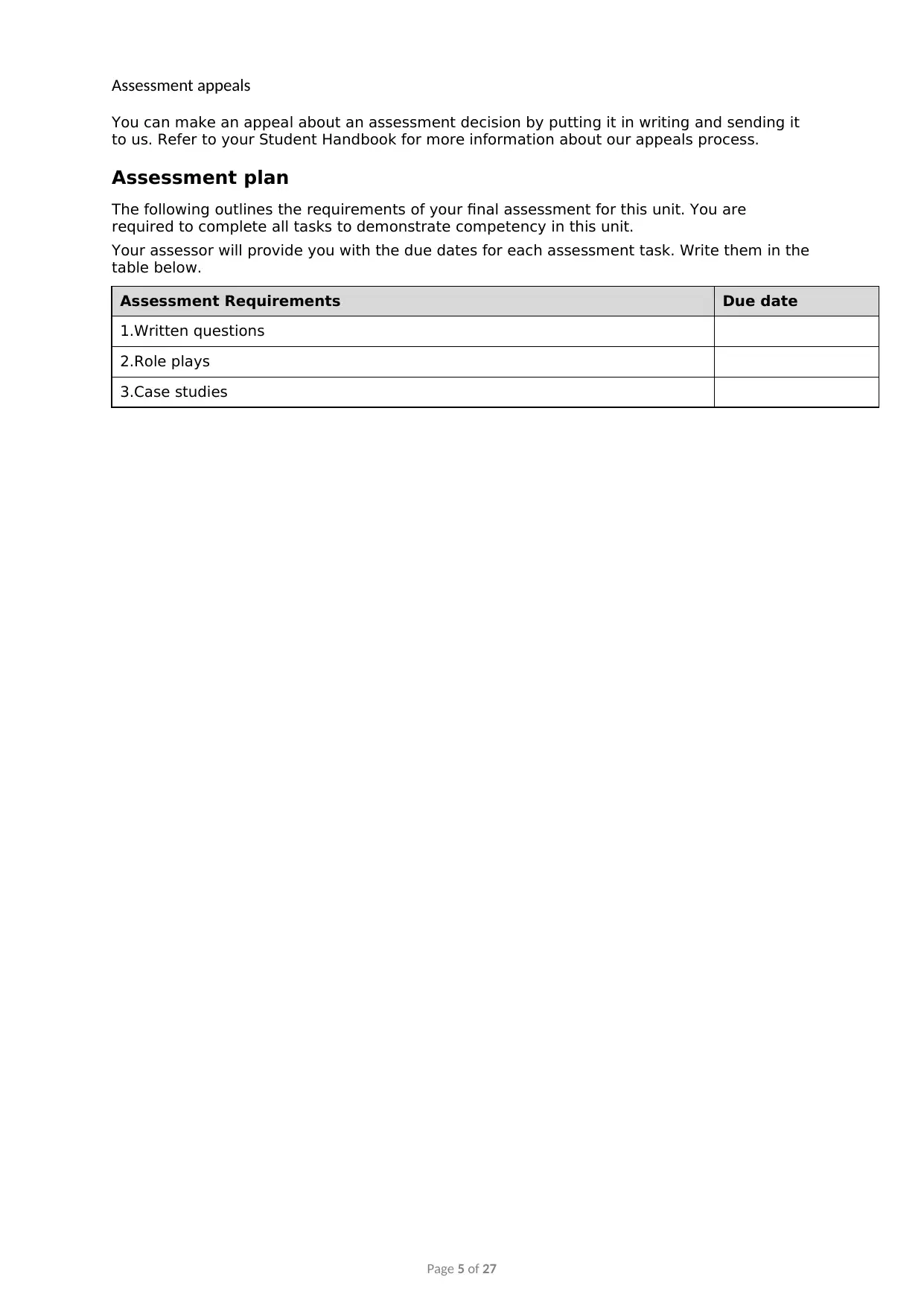
Assessment appeals
You can make an appeal about an assessment decision by putting it in writing and sending it
to us. Refer to your Student Handbook for more information about our appeals process.
Assessment plan
The following outlines the requirements of your final assessment for this unit. You are
required to complete all tasks to demonstrate competency in this unit.
Your assessor will provide you with the due dates for each assessment task. Write them in the
table below.
Assessment Requirements Due date
1.Written questions
2.Role plays
3.Case studies
Page 5 of 27
You can make an appeal about an assessment decision by putting it in writing and sending it
to us. Refer to your Student Handbook for more information about our appeals process.
Assessment plan
The following outlines the requirements of your final assessment for this unit. You are
required to complete all tasks to demonstrate competency in this unit.
Your assessor will provide you with the due dates for each assessment task. Write them in the
table below.
Assessment Requirements Due date
1.Written questions
2.Role plays
3.Case studies
Page 5 of 27
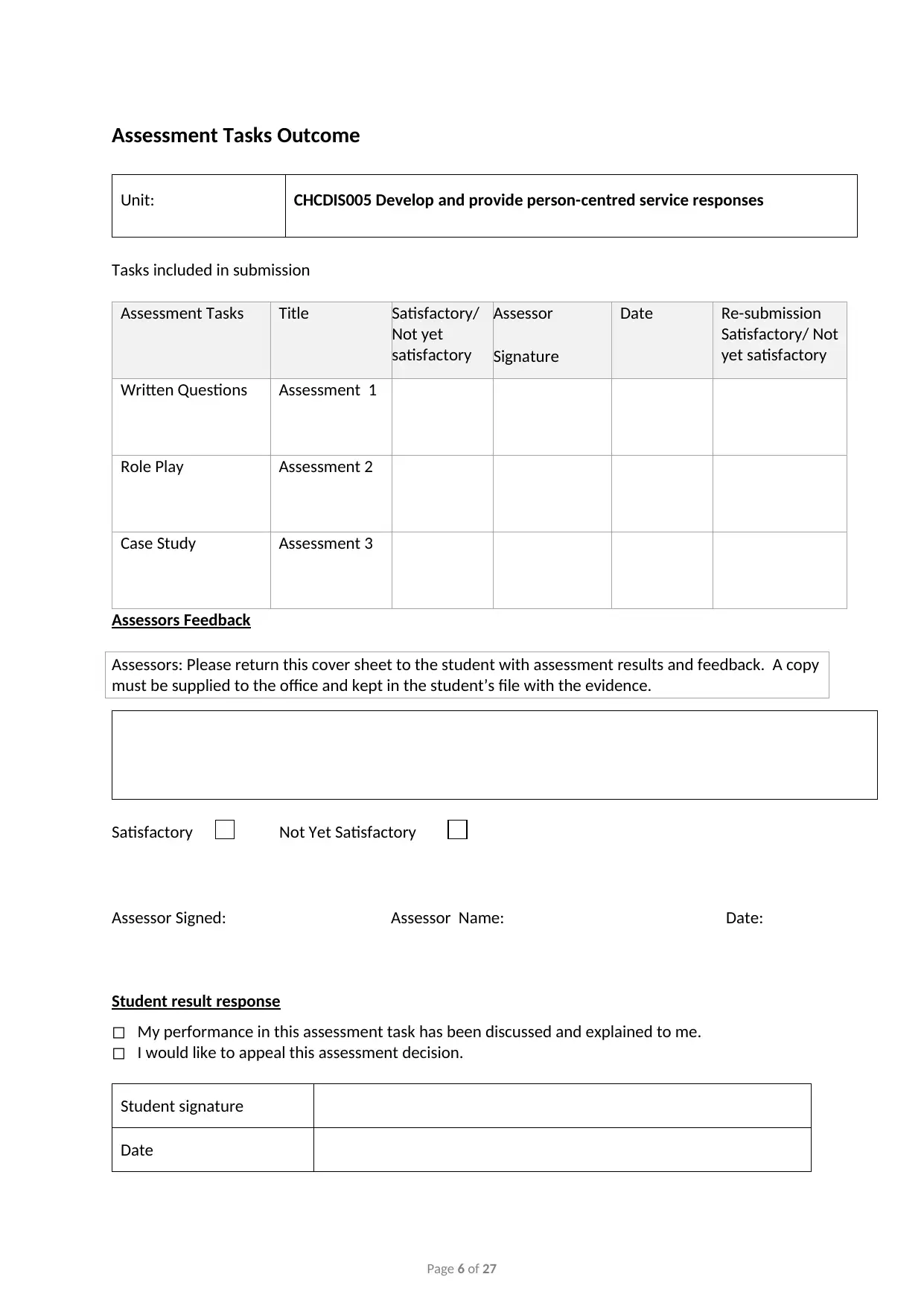
Assessment Tasks Outcome
Unit: CHCDIS005 Develop and provide person-centred service responses
Tasks included in submission
Assessment Tasks Title Satisfactory/
Not yet
satisfactory
Assessor
Signature
Date Re-submission
Satisfactory/ Not
yet satisfactory
Written Questions Assessment 1
Role Play Assessment 2
Case Study Assessment 3
Assessors Feedback
Assessors: Please return this cover sheet to the student with assessment results and feedback. A copy
must be supplied to the office and kept in the student’s file with the evidence.
Satisfactory Not Yet Satisfactory
Assessor Signed: Assessor Name: Date:
Student result response
◻ My performance in this assessment task has been discussed and explained to me.
◻ I would like to appeal this assessment decision.
Student signature
Date
Page 6 of 27
Unit: CHCDIS005 Develop and provide person-centred service responses
Tasks included in submission
Assessment Tasks Title Satisfactory/
Not yet
satisfactory
Assessor
Signature
Date Re-submission
Satisfactory/ Not
yet satisfactory
Written Questions Assessment 1
Role Play Assessment 2
Case Study Assessment 3
Assessors Feedback
Assessors: Please return this cover sheet to the student with assessment results and feedback. A copy
must be supplied to the office and kept in the student’s file with the evidence.
Satisfactory Not Yet Satisfactory
Assessor Signed: Assessor Name: Date:
Student result response
◻ My performance in this assessment task has been discussed and explained to me.
◻ I would like to appeal this assessment decision.
Student signature
Date
Page 6 of 27
⊘ This is a preview!⊘
Do you want full access?
Subscribe today to unlock all pages.

Trusted by 1+ million students worldwide
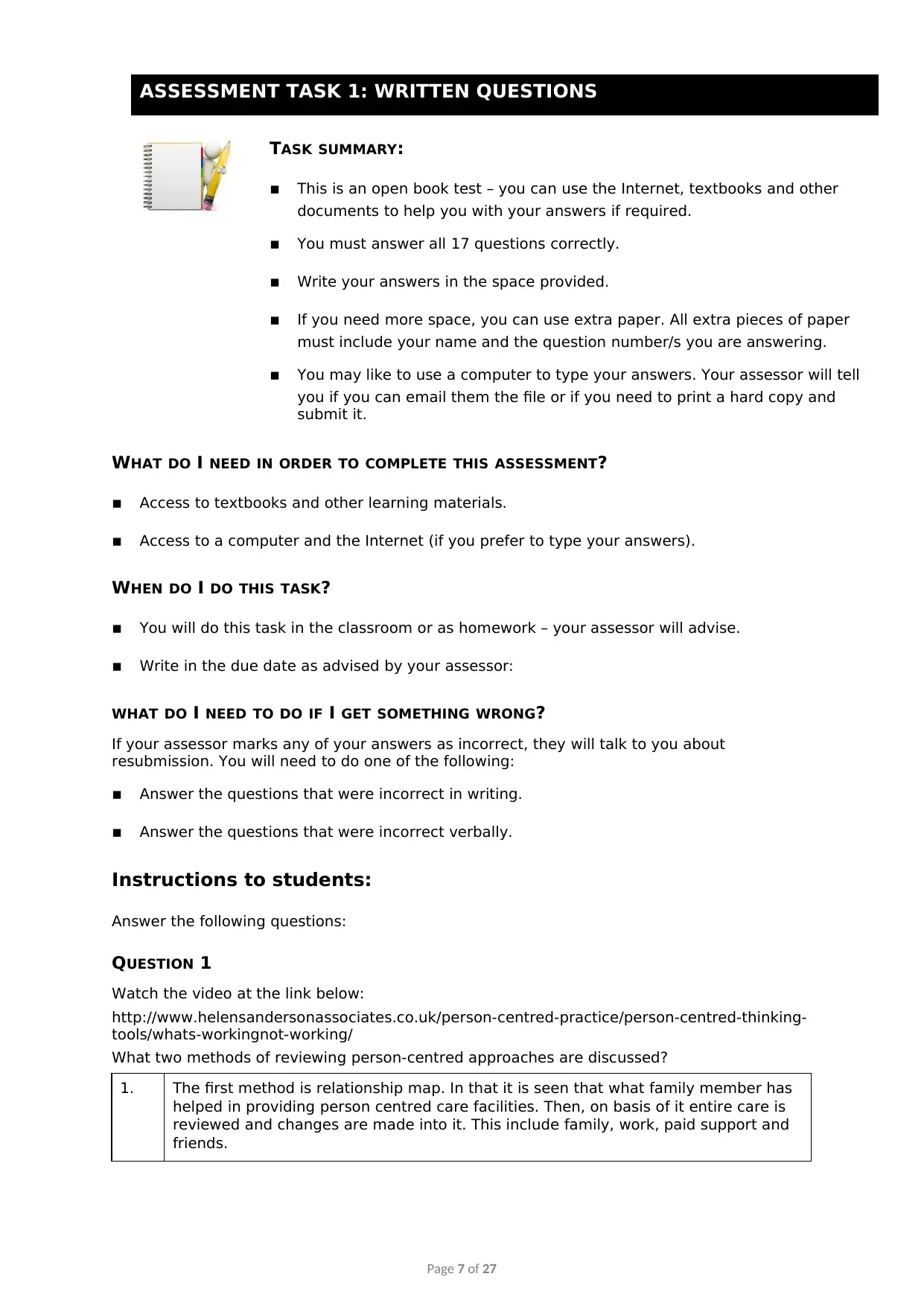
ASSESSMENT TASK 1: WRITTEN QUESTIONS
TASK SUMMARY:
▪ This is an open book test – you can use the Internet, textbooks and other
documents to help you with your answers if required.
▪ You must answer all 17 questions correctly.
▪ Write your answers in the space provided.
▪ If you need more space, you can use extra paper. All extra pieces of paper
must include your name and the question number/s you are answering.
▪ You may like to use a computer to type your answers. Your assessor will tell
you if you can email them the file or if you need to print a hard copy and
submit it.
WHAT DO I NEED IN ORDER TO COMPLETE THIS ASSESSMENT?
▪ Access to textbooks and other learning materials.
▪ Access to a computer and the Internet (if you prefer to type your answers).
WHEN DO I DO THIS TASK?
▪ You will do this task in the classroom or as homework – your assessor will advise.
▪ Write in the due date as advised by your assessor:
WHAT DO I NEED TO DO IF I GET SOMETHING WRONG?
If your assessor marks any of your answers as incorrect, they will talk to you about
resubmission. You will need to do one of the following:
▪ Answer the questions that were incorrect in writing.
▪ Answer the questions that were incorrect verbally.
Instructions to students:
Answer the following questions:
QUESTION 1
Watch the video at the link below:
http://www.helensandersonassociates.co.uk/person-centred-practice/person-centred-thinking-
tools/whats-workingnot-working/
What two methods of reviewing person-centred approaches are discussed?
1. The first method is relationship map. In that it is seen that what family member has
helped in providing person centred care facilities. Then, on basis of it entire care is
reviewed and changes are made into it. This include family, work, paid support and
friends.
Page 7 of 27
TASK SUMMARY:
▪ This is an open book test – you can use the Internet, textbooks and other
documents to help you with your answers if required.
▪ You must answer all 17 questions correctly.
▪ Write your answers in the space provided.
▪ If you need more space, you can use extra paper. All extra pieces of paper
must include your name and the question number/s you are answering.
▪ You may like to use a computer to type your answers. Your assessor will tell
you if you can email them the file or if you need to print a hard copy and
submit it.
WHAT DO I NEED IN ORDER TO COMPLETE THIS ASSESSMENT?
▪ Access to textbooks and other learning materials.
▪ Access to a computer and the Internet (if you prefer to type your answers).
WHEN DO I DO THIS TASK?
▪ You will do this task in the classroom or as homework – your assessor will advise.
▪ Write in the due date as advised by your assessor:
WHAT DO I NEED TO DO IF I GET SOMETHING WRONG?
If your assessor marks any of your answers as incorrect, they will talk to you about
resubmission. You will need to do one of the following:
▪ Answer the questions that were incorrect in writing.
▪ Answer the questions that were incorrect verbally.
Instructions to students:
Answer the following questions:
QUESTION 1
Watch the video at the link below:
http://www.helensandersonassociates.co.uk/person-centred-practice/person-centred-thinking-
tools/whats-workingnot-working/
What two methods of reviewing person-centred approaches are discussed?
1. The first method is relationship map. In that it is seen that what family member has
helped in providing person centred care facilities. Then, on basis of it entire care is
reviewed and changes are made into it. This include family, work, paid support and
friends.
Page 7 of 27
Paraphrase This Document
Need a fresh take? Get an instant paraphrase of this document with our AI Paraphraser
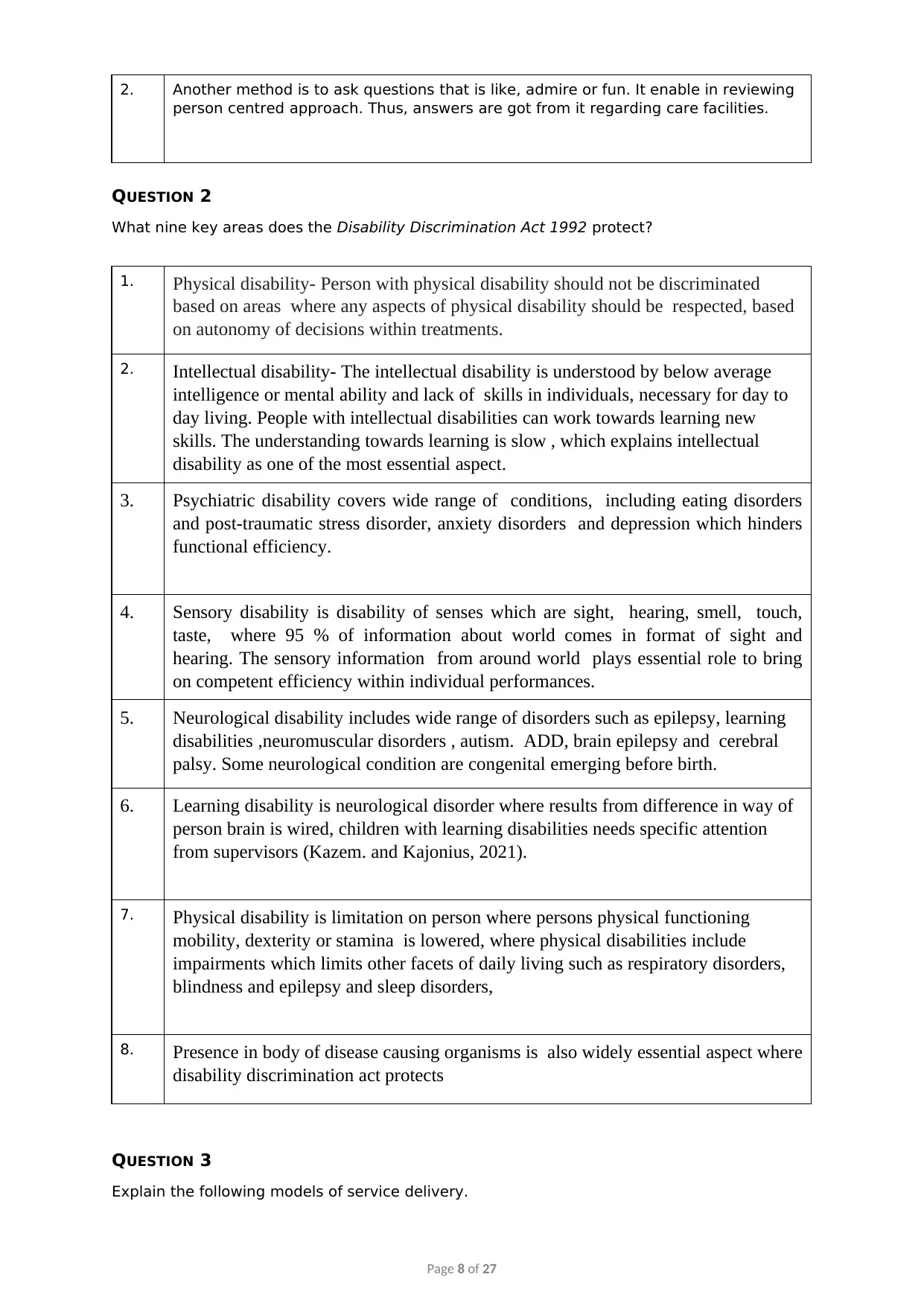
2. Another method is to ask questions that is like, admire or fun. It enable in reviewing
person centred approach. Thus, answers are got from it regarding care facilities.
QUESTION 2
What nine key areas does the Disability Discrimination Act 1992 protect?
1. Physical disability- Person with physical disability should not be discriminated
based on areas where any aspects of physical disability should be respected, based
on autonomy of decisions within treatments.
2. Intellectual disability- The intellectual disability is understood by below average
intelligence or mental ability and lack of skills in individuals, necessary for day to
day living. People with intellectual disabilities can work towards learning new
skills. The understanding towards learning is slow , which explains intellectual
disability as one of the most essential aspect.
3. Psychiatric disability covers wide range of conditions, including eating disorders
and post-traumatic stress disorder, anxiety disorders and depression which hinders
functional efficiency.
4. Sensory disability is disability of senses which are sight, hearing, smell, touch,
taste, where 95 % of information about world comes in format of sight and
hearing. The sensory information from around world plays essential role to bring
on competent efficiency within individual performances.
5. Neurological disability includes wide range of disorders such as epilepsy, learning
disabilities ,neuromuscular disorders , autism. ADD, brain epilepsy and cerebral
palsy. Some neurological condition are congenital emerging before birth.
6. Learning disability is neurological disorder where results from difference in way of
person brain is wired, children with learning disabilities needs specific attention
from supervisors (Kazem. and Kajonius, 2021).
7. Physical disability is limitation on person where persons physical functioning
mobility, dexterity or stamina is lowered, where physical disabilities include
impairments which limits other facets of daily living such as respiratory disorders,
blindness and epilepsy and sleep disorders,
8. Presence in body of disease causing organisms is also widely essential aspect where
disability discrimination act protects
QUESTION 3
Explain the following models of service delivery.
Page 8 of 27
person centred approach. Thus, answers are got from it regarding care facilities.
QUESTION 2
What nine key areas does the Disability Discrimination Act 1992 protect?
1. Physical disability- Person with physical disability should not be discriminated
based on areas where any aspects of physical disability should be respected, based
on autonomy of decisions within treatments.
2. Intellectual disability- The intellectual disability is understood by below average
intelligence or mental ability and lack of skills in individuals, necessary for day to
day living. People with intellectual disabilities can work towards learning new
skills. The understanding towards learning is slow , which explains intellectual
disability as one of the most essential aspect.
3. Psychiatric disability covers wide range of conditions, including eating disorders
and post-traumatic stress disorder, anxiety disorders and depression which hinders
functional efficiency.
4. Sensory disability is disability of senses which are sight, hearing, smell, touch,
taste, where 95 % of information about world comes in format of sight and
hearing. The sensory information from around world plays essential role to bring
on competent efficiency within individual performances.
5. Neurological disability includes wide range of disorders such as epilepsy, learning
disabilities ,neuromuscular disorders , autism. ADD, brain epilepsy and cerebral
palsy. Some neurological condition are congenital emerging before birth.
6. Learning disability is neurological disorder where results from difference in way of
person brain is wired, children with learning disabilities needs specific attention
from supervisors (Kazem. and Kajonius, 2021).
7. Physical disability is limitation on person where persons physical functioning
mobility, dexterity or stamina is lowered, where physical disabilities include
impairments which limits other facets of daily living such as respiratory disorders,
blindness and epilepsy and sleep disorders,
8. Presence in body of disease causing organisms is also widely essential aspect where
disability discrimination act protects
QUESTION 3
Explain the following models of service delivery.
Page 8 of 27
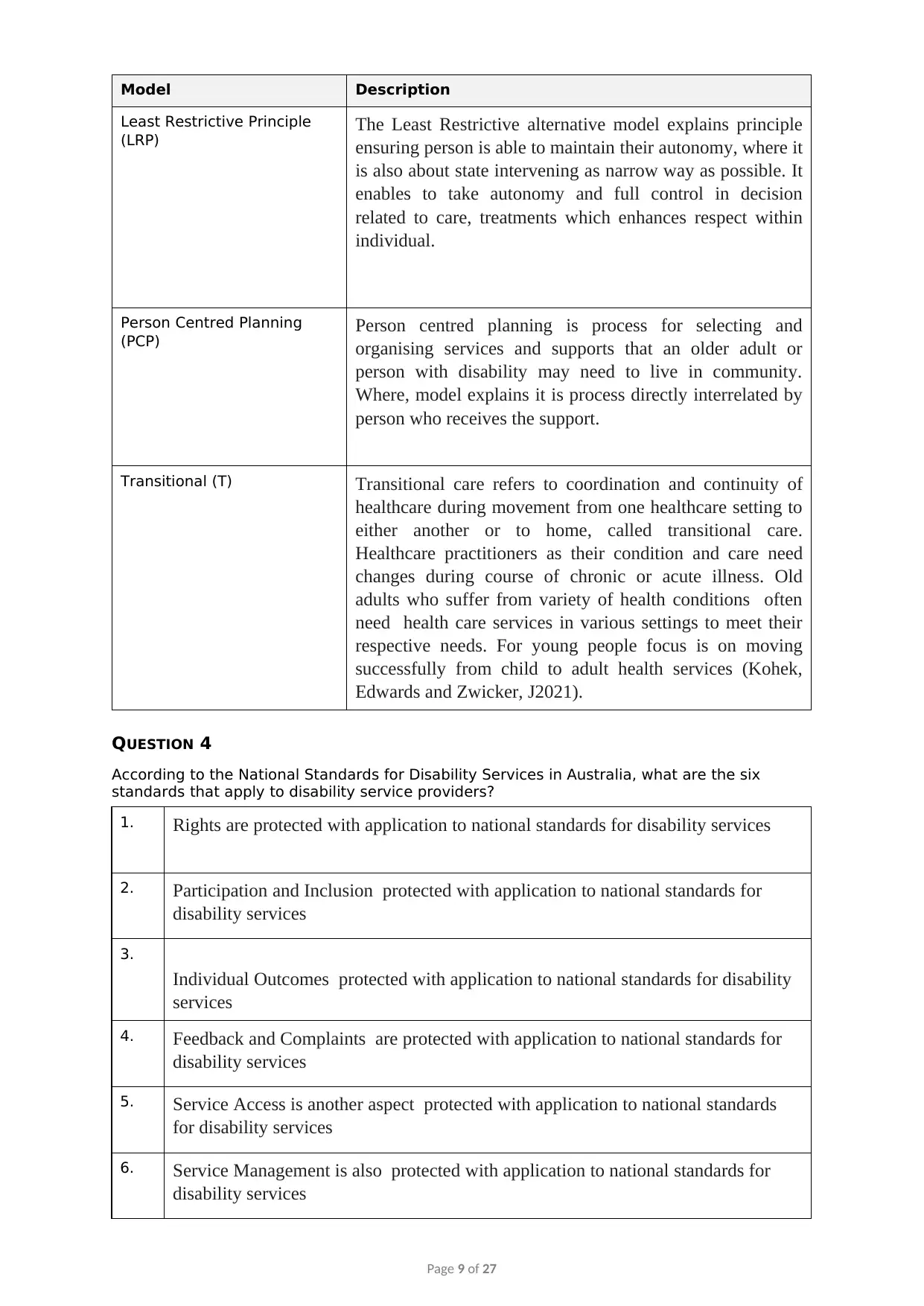
Model Description
Least Restrictive Principle
(LRP) The Least Restrictive alternative model explains principle
ensuring person is able to maintain their autonomy, where it
is also about state intervening as narrow way as possible. It
enables to take autonomy and full control in decision
related to care, treatments which enhances respect within
individual.
Person Centred Planning
(PCP) Person centred planning is process for selecting and
organising services and supports that an older adult or
person with disability may need to live in community.
Where, model explains it is process directly interrelated by
person who receives the support.
Transitional (T) Transitional care refers to coordination and continuity of
healthcare during movement from one healthcare setting to
either another or to home, called transitional care.
Healthcare practitioners as their condition and care need
changes during course of chronic or acute illness. Old
adults who suffer from variety of health conditions often
need health care services in various settings to meet their
respective needs. For young people focus is on moving
successfully from child to adult health services (Kohek,
Edwards and Zwicker, J2021).
QUESTION 4
According to the National Standards for Disability Services in Australia, what are the six
standards that apply to disability service providers?
1. Rights are protected with application to national standards for disability services
2. Participation and Inclusion protected with application to national standards for
disability services
3.
Individual Outcomes protected with application to national standards for disability
services
4. Feedback and Complaints are protected with application to national standards for
disability services
5. Service Access is another aspect protected with application to national standards
for disability services
6. Service Management is also protected with application to national standards for
disability services
Page 9 of 27
Least Restrictive Principle
(LRP) The Least Restrictive alternative model explains principle
ensuring person is able to maintain their autonomy, where it
is also about state intervening as narrow way as possible. It
enables to take autonomy and full control in decision
related to care, treatments which enhances respect within
individual.
Person Centred Planning
(PCP) Person centred planning is process for selecting and
organising services and supports that an older adult or
person with disability may need to live in community.
Where, model explains it is process directly interrelated by
person who receives the support.
Transitional (T) Transitional care refers to coordination and continuity of
healthcare during movement from one healthcare setting to
either another or to home, called transitional care.
Healthcare practitioners as their condition and care need
changes during course of chronic or acute illness. Old
adults who suffer from variety of health conditions often
need health care services in various settings to meet their
respective needs. For young people focus is on moving
successfully from child to adult health services (Kohek,
Edwards and Zwicker, J2021).
QUESTION 4
According to the National Standards for Disability Services in Australia, what are the six
standards that apply to disability service providers?
1. Rights are protected with application to national standards for disability services
2. Participation and Inclusion protected with application to national standards for
disability services
3.
Individual Outcomes protected with application to national standards for disability
services
4. Feedback and Complaints are protected with application to national standards for
disability services
5. Service Access is another aspect protected with application to national standards
for disability services
6. Service Management is also protected with application to national standards for
disability services
Page 9 of 27
⊘ This is a preview!⊘
Do you want full access?
Subscribe today to unlock all pages.

Trusted by 1+ million students worldwide
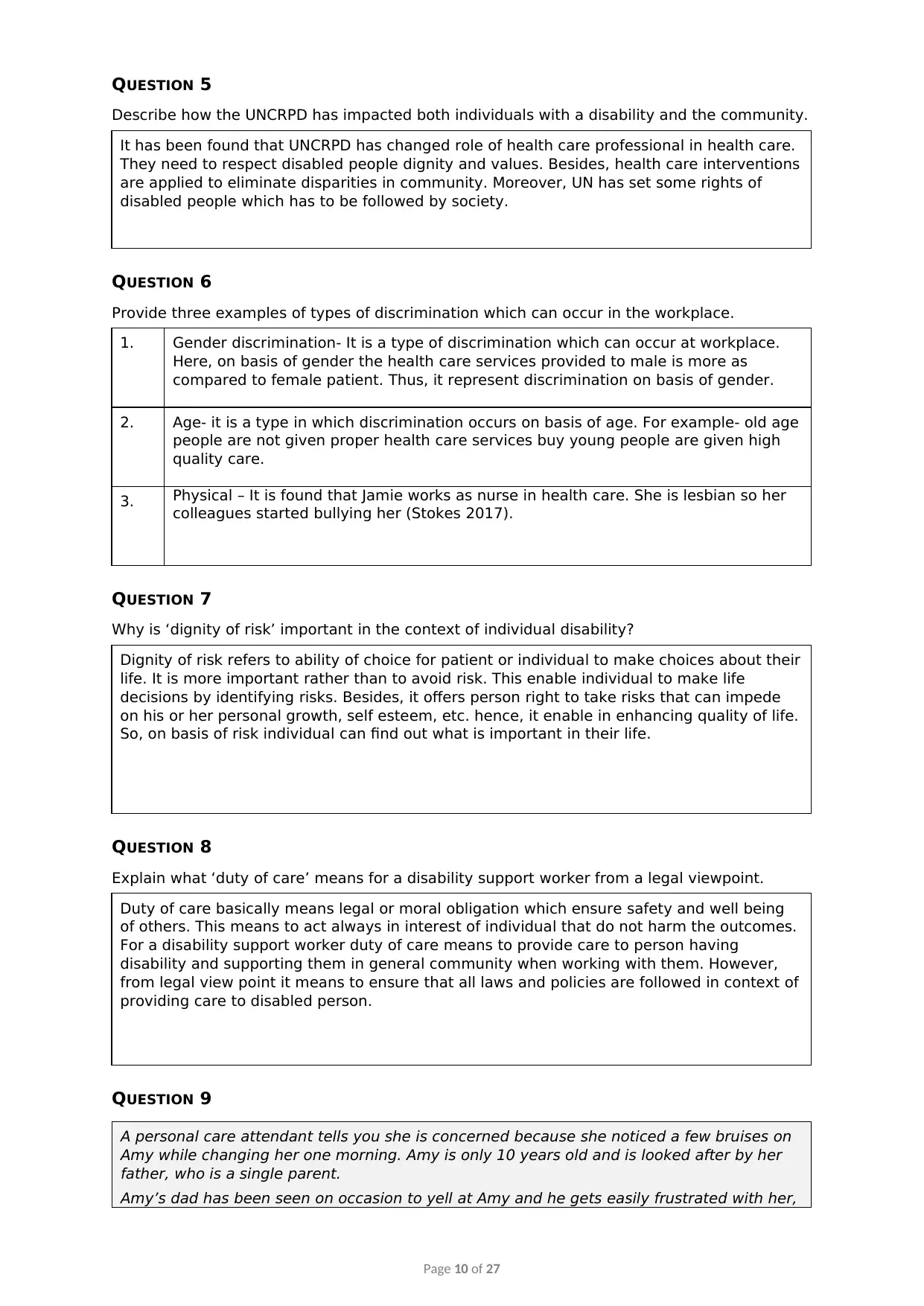
QUESTION 5
Describe how the UNCRPD has impacted both individuals with a disability and the community.
It has been found that UNCRPD has changed role of health care professional in health care.
They need to respect disabled people dignity and values. Besides, health care interventions
are applied to eliminate disparities in community. Moreover, UN has set some rights of
disabled people which has to be followed by society.
QUESTION 6
Provide three examples of types of discrimination which can occur in the workplace.
1. Gender discrimination- It is a type of discrimination which can occur at workplace.
Here, on basis of gender the health care services provided to male is more as
compared to female patient. Thus, it represent discrimination on basis of gender.
2. Age- it is a type in which discrimination occurs on basis of age. For example- old age
people are not given proper health care services buy young people are given high
quality care.
3. Physical – It is found that Jamie works as nurse in health care. She is lesbian so her
colleagues started bullying her (Stokes 2017).
QUESTION 7
Why is ‘dignity of risk’ important in the context of individual disability?
Dignity of risk refers to ability of choice for patient or individual to make choices about their
life. It is more important rather than to avoid risk. This enable individual to make life
decisions by identifying risks. Besides, it offers person right to take risks that can impede
on his or her personal growth, self esteem, etc. hence, it enable in enhancing quality of life.
So, on basis of risk individual can find out what is important in their life.
QUESTION 8
Explain what ‘duty of care’ means for a disability support worker from a legal viewpoint.
Duty of care basically means legal or moral obligation which ensure safety and well being
of others. This means to act always in interest of individual that do not harm the outcomes.
For a disability support worker duty of care means to provide care to person having
disability and supporting them in general community when working with them. However,
from legal view point it means to ensure that all laws and policies are followed in context of
providing care to disabled person.
QUESTION 9
A personal care attendant tells you she is concerned because she noticed a few bruises on
Amy while changing her one morning. Amy is only 10 years old and is looked after by her
father, who is a single parent.
Amy’s dad has been seen on occasion to yell at Amy and he gets easily frustrated with her,
Page 10 of 27
Describe how the UNCRPD has impacted both individuals with a disability and the community.
It has been found that UNCRPD has changed role of health care professional in health care.
They need to respect disabled people dignity and values. Besides, health care interventions
are applied to eliminate disparities in community. Moreover, UN has set some rights of
disabled people which has to be followed by society.
QUESTION 6
Provide three examples of types of discrimination which can occur in the workplace.
1. Gender discrimination- It is a type of discrimination which can occur at workplace.
Here, on basis of gender the health care services provided to male is more as
compared to female patient. Thus, it represent discrimination on basis of gender.
2. Age- it is a type in which discrimination occurs on basis of age. For example- old age
people are not given proper health care services buy young people are given high
quality care.
3. Physical – It is found that Jamie works as nurse in health care. She is lesbian so her
colleagues started bullying her (Stokes 2017).
QUESTION 7
Why is ‘dignity of risk’ important in the context of individual disability?
Dignity of risk refers to ability of choice for patient or individual to make choices about their
life. It is more important rather than to avoid risk. This enable individual to make life
decisions by identifying risks. Besides, it offers person right to take risks that can impede
on his or her personal growth, self esteem, etc. hence, it enable in enhancing quality of life.
So, on basis of risk individual can find out what is important in their life.
QUESTION 8
Explain what ‘duty of care’ means for a disability support worker from a legal viewpoint.
Duty of care basically means legal or moral obligation which ensure safety and well being
of others. This means to act always in interest of individual that do not harm the outcomes.
For a disability support worker duty of care means to provide care to person having
disability and supporting them in general community when working with them. However,
from legal view point it means to ensure that all laws and policies are followed in context of
providing care to disabled person.
QUESTION 9
A personal care attendant tells you she is concerned because she noticed a few bruises on
Amy while changing her one morning. Amy is only 10 years old and is looked after by her
father, who is a single parent.
Amy’s dad has been seen on occasion to yell at Amy and he gets easily frustrated with her,
Page 10 of 27
Paraphrase This Document
Need a fresh take? Get an instant paraphrase of this document with our AI Paraphraser
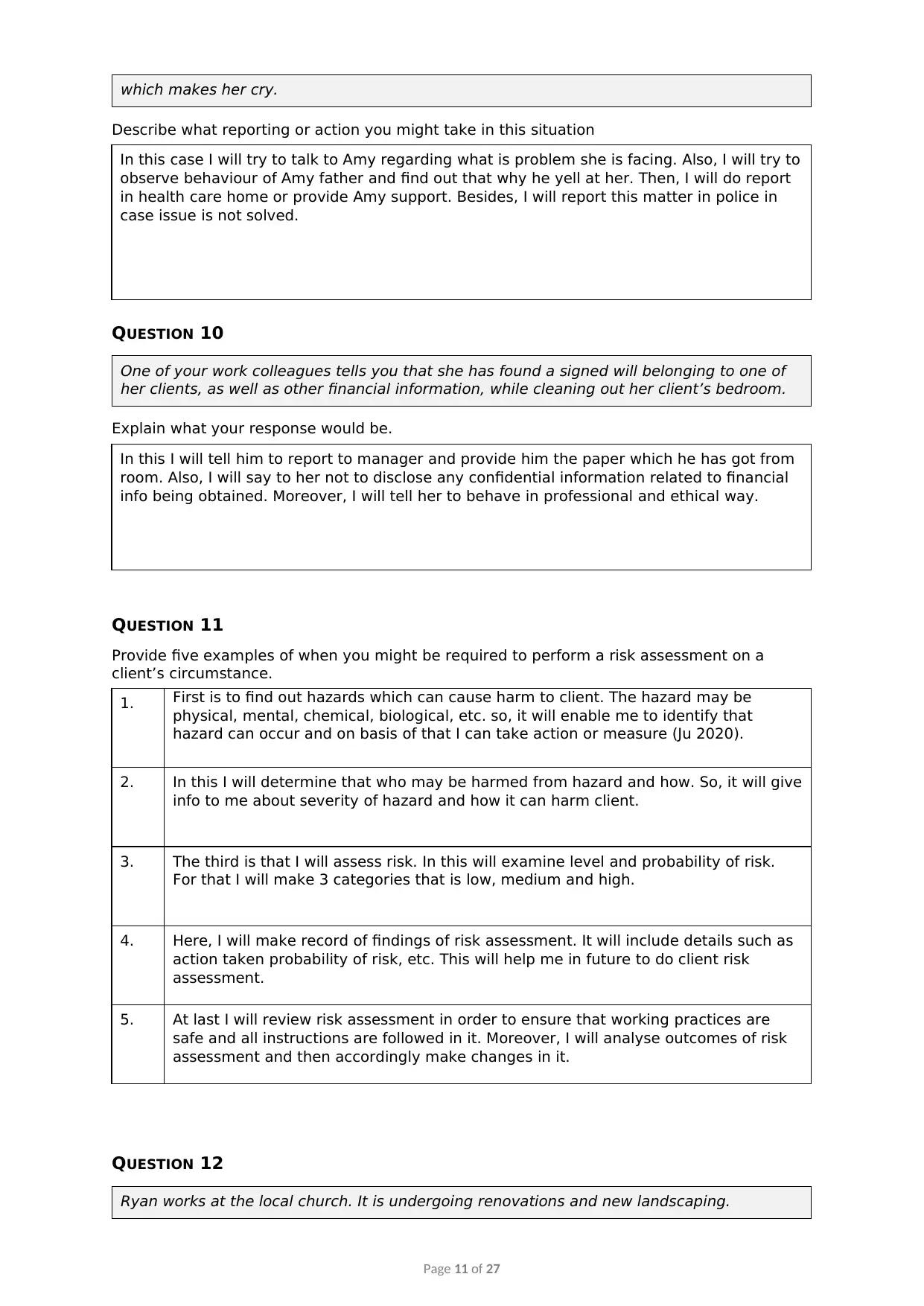
which makes her cry.
Describe what reporting or action you might take in this situation
In this case I will try to talk to Amy regarding what is problem she is facing. Also, I will try to
observe behaviour of Amy father and find out that why he yell at her. Then, I will do report
in health care home or provide Amy support. Besides, I will report this matter in police in
case issue is not solved.
QUESTION 10
One of your work colleagues tells you that she has found a signed will belonging to one of
her clients, as well as other financial information, while cleaning out her client’s bedroom.
Explain what your response would be.
In this I will tell him to report to manager and provide him the paper which he has got from
room. Also, I will say to her not to disclose any confidential information related to financial
info being obtained. Moreover, I will tell her to behave in professional and ethical way.
QUESTION 11
Provide five examples of when you might be required to perform a risk assessment on a
client’s circumstance.
1. First is to find out hazards which can cause harm to client. The hazard may be
physical, mental, chemical, biological, etc. so, it will enable me to identify that
hazard can occur and on basis of that I can take action or measure (Ju 2020).
2. In this I will determine that who may be harmed from hazard and how. So, it will give
info to me about severity of hazard and how it can harm client.
3. The third is that I will assess risk. In this will examine level and probability of risk.
For that I will make 3 categories that is low, medium and high.
4. Here, I will make record of findings of risk assessment. It will include details such as
action taken probability of risk, etc. This will help me in future to do client risk
assessment.
5. At last I will review risk assessment in order to ensure that working practices are
safe and all instructions are followed in it. Moreover, I will analyse outcomes of risk
assessment and then accordingly make changes in it.
QUESTION 12
Ryan works at the local church. It is undergoing renovations and new landscaping.
Page 11 of 27
Describe what reporting or action you might take in this situation
In this case I will try to talk to Amy regarding what is problem she is facing. Also, I will try to
observe behaviour of Amy father and find out that why he yell at her. Then, I will do report
in health care home or provide Amy support. Besides, I will report this matter in police in
case issue is not solved.
QUESTION 10
One of your work colleagues tells you that she has found a signed will belonging to one of
her clients, as well as other financial information, while cleaning out her client’s bedroom.
Explain what your response would be.
In this I will tell him to report to manager and provide him the paper which he has got from
room. Also, I will say to her not to disclose any confidential information related to financial
info being obtained. Moreover, I will tell her to behave in professional and ethical way.
QUESTION 11
Provide five examples of when you might be required to perform a risk assessment on a
client’s circumstance.
1. First is to find out hazards which can cause harm to client. The hazard may be
physical, mental, chemical, biological, etc. so, it will enable me to identify that
hazard can occur and on basis of that I can take action or measure (Ju 2020).
2. In this I will determine that who may be harmed from hazard and how. So, it will give
info to me about severity of hazard and how it can harm client.
3. The third is that I will assess risk. In this will examine level and probability of risk.
For that I will make 3 categories that is low, medium and high.
4. Here, I will make record of findings of risk assessment. It will include details such as
action taken probability of risk, etc. This will help me in future to do client risk
assessment.
5. At last I will review risk assessment in order to ensure that working practices are
safe and all instructions are followed in it. Moreover, I will analyse outcomes of risk
assessment and then accordingly make changes in it.
QUESTION 12
Ryan works at the local church. It is undergoing renovations and new landscaping.
Page 11 of 27
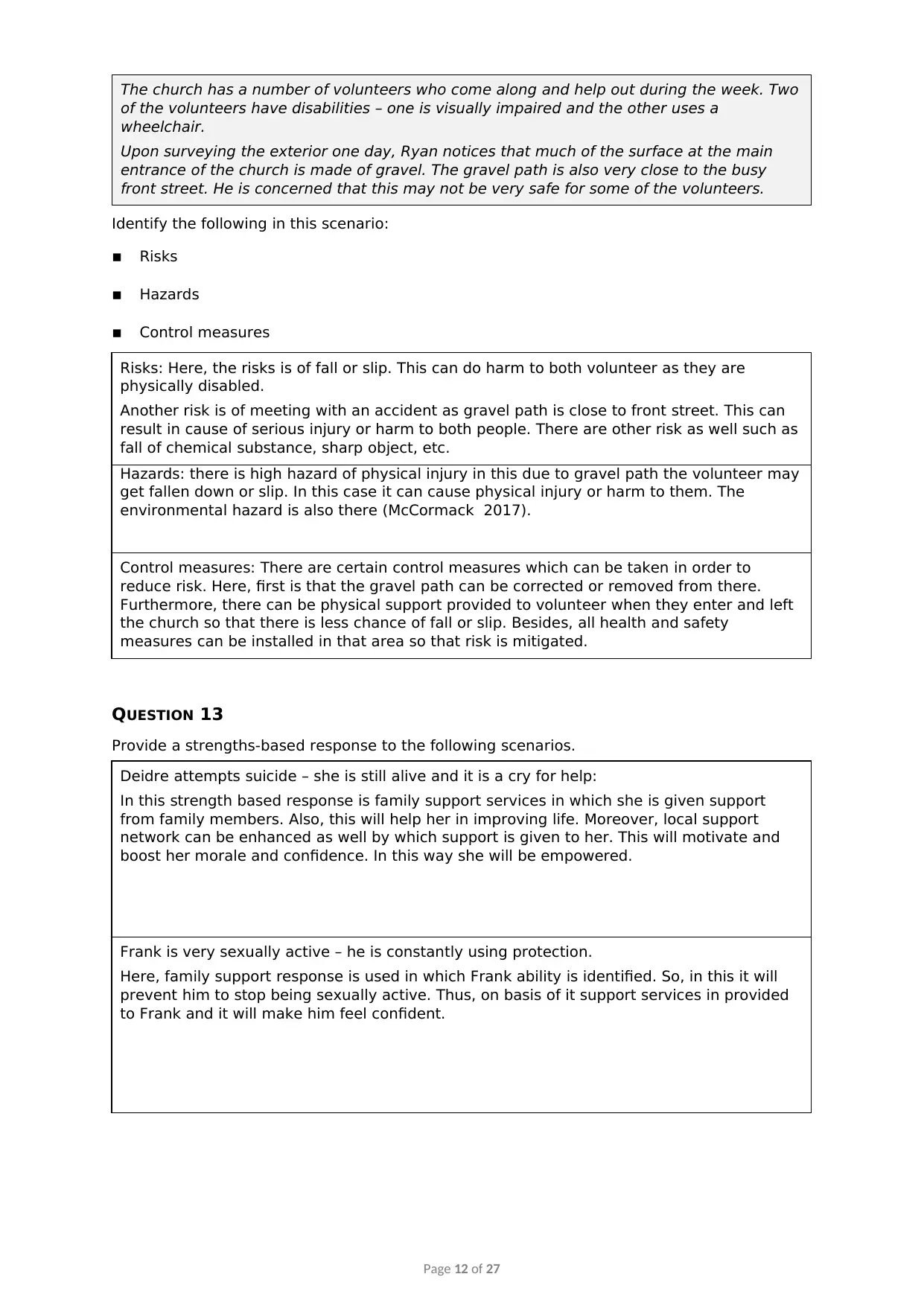
The church has a number of volunteers who come along and help out during the week. Two
of the volunteers have disabilities – one is visually impaired and the other uses a
wheelchair.
Upon surveying the exterior one day, Ryan notices that much of the surface at the main
entrance of the church is made of gravel. The gravel path is also very close to the busy
front street. He is concerned that this may not be very safe for some of the volunteers.
Identify the following in this scenario:
▪ Risks
▪ Hazards
▪ Control measures
Risks: Here, the risks is of fall or slip. This can do harm to both volunteer as they are
physically disabled.
Another risk is of meeting with an accident as gravel path is close to front street. This can
result in cause of serious injury or harm to both people. There are other risk as well such as
fall of chemical substance, sharp object, etc.
Hazards: there is high hazard of physical injury in this due to gravel path the volunteer may
get fallen down or slip. In this case it can cause physical injury or harm to them. The
environmental hazard is also there (McCormack 2017).
Control measures: There are certain control measures which can be taken in order to
reduce risk. Here, first is that the gravel path can be corrected or removed from there.
Furthermore, there can be physical support provided to volunteer when they enter and left
the church so that there is less chance of fall or slip. Besides, all health and safety
measures can be installed in that area so that risk is mitigated.
QUESTION 13
Provide a strengths-based response to the following scenarios.
Deidre attempts suicide – she is still alive and it is a cry for help:
In this strength based response is family support services in which she is given support
from family members. Also, this will help her in improving life. Moreover, local support
network can be enhanced as well by which support is given to her. This will motivate and
boost her morale and confidence. In this way she will be empowered.
Frank is very sexually active – he is constantly using protection.
Here, family support response is used in which Frank ability is identified. So, in this it will
prevent him to stop being sexually active. Thus, on basis of it support services in provided
to Frank and it will make him feel confident.
Page 12 of 27
of the volunteers have disabilities – one is visually impaired and the other uses a
wheelchair.
Upon surveying the exterior one day, Ryan notices that much of the surface at the main
entrance of the church is made of gravel. The gravel path is also very close to the busy
front street. He is concerned that this may not be very safe for some of the volunteers.
Identify the following in this scenario:
▪ Risks
▪ Hazards
▪ Control measures
Risks: Here, the risks is of fall or slip. This can do harm to both volunteer as they are
physically disabled.
Another risk is of meeting with an accident as gravel path is close to front street. This can
result in cause of serious injury or harm to both people. There are other risk as well such as
fall of chemical substance, sharp object, etc.
Hazards: there is high hazard of physical injury in this due to gravel path the volunteer may
get fallen down or slip. In this case it can cause physical injury or harm to them. The
environmental hazard is also there (McCormack 2017).
Control measures: There are certain control measures which can be taken in order to
reduce risk. Here, first is that the gravel path can be corrected or removed from there.
Furthermore, there can be physical support provided to volunteer when they enter and left
the church so that there is less chance of fall or slip. Besides, all health and safety
measures can be installed in that area so that risk is mitigated.
QUESTION 13
Provide a strengths-based response to the following scenarios.
Deidre attempts suicide – she is still alive and it is a cry for help:
In this strength based response is family support services in which she is given support
from family members. Also, this will help her in improving life. Moreover, local support
network can be enhanced as well by which support is given to her. This will motivate and
boost her morale and confidence. In this way she will be empowered.
Frank is very sexually active – he is constantly using protection.
Here, family support response is used in which Frank ability is identified. So, in this it will
prevent him to stop being sexually active. Thus, on basis of it support services in provided
to Frank and it will make him feel confident.
Page 12 of 27
⊘ This is a preview!⊘
Do you want full access?
Subscribe today to unlock all pages.

Trusted by 1+ million students worldwide
1 out of 27
Related Documents
Your All-in-One AI-Powered Toolkit for Academic Success.
+13062052269
info@desklib.com
Available 24*7 on WhatsApp / Email
![[object Object]](/_next/static/media/star-bottom.7253800d.svg)
Unlock your academic potential
Copyright © 2020–2025 A2Z Services. All Rights Reserved. Developed and managed by ZUCOL.





